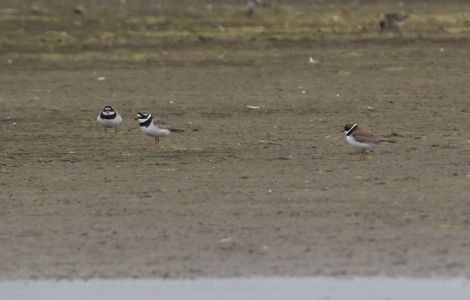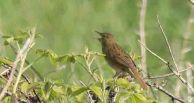| Sighting Ref : |
IB89564 |
| Sighting Date : |
26 Jul 16 |
| Common Name : |
Semipalmated Plover |
| Scientific Name : |
Charadrius semipalmatus |
| Location : |
Tacumshin |
| County : |
Wexford |
| Number Seen : |
1 |
| Principal Observer(s) : |
Killian Mullarney, Pat Lonergan
Not Specified
|
| Reported By : |
Not Specified
|
| Comments : |
10:15 Adult breeding plumage. NW corner of main lake (where the PGP was) associating with Ringed Plover flock, c. 60. I have to admit, I could hardly believe it myself when I initially noticed this bird at long range while Pat and I tried to relocate the Western Sandpiper we had seen briefly in the early morning. I occasionally see Ringed Plovers with a very wide black forehead band and correspondingly limited white just above the bill. Intriguingly however, I sensed that this bird was also slightly smaller than the psammodroma Ringed Plovers (which is in turn smaller than our breeding birds) alongside it and it had a rather narrow breastband. With growing excitement we approached the bird and it became more and more obvious as we did so that it really had to be a Semipalmated Plover!
Of course the first question that comes to mind is "could the May/June first-summer have acquired an adult breeding plumage since we last saw it in early June?" I'm open to correction but I believe the answer to this question is no, it couldn't. Apart from references in the literature to 2nd cal-year birds not having as fully developed breeding plumage as adults, the fact that the previous bird had commenced primary moult by 6 June (with the innermost primary dropped on each wing) while today's bird appears to have all-the-same-generation, slightly faded primaries, with no moult gaps or contrasts, suggests they cannot be the same bird.
One thing to be aware of, anyone who might be looking for this bird in the coming days, some Ringed Plovers (especially, it seems to me, Greenland birds ssp psammodroma) can have an extensively black forehead with very restricted white above the bill and are thus similar to the Semipalmated. Note that the Semip lacks a white supercilium just behind the eye, a feature seldom if ever lacking in Ringeds.
In spite of searching all likely spots up until around 6.00 pm, Pat and I did not manage to relocate the bird after it vanished around 11.15, but others reported seeing it again around 14.30. Incidentally, it was not very vocal; we heard it only once in the just under two hours we watched it. 4th Irish record
|
| Status : |
See IRBC Appendix 1 |
|
| Photos : |
|
|
| Photographer(s) : |
©
Killian Mullarney
|
|
 |
Printer Friendly Version |
Copyright © all sightings, photographs and articles 2000-2022










